- Home
- David Eddings
The Rivan Codex Page 11
The Rivan Codex Read online
Page 11
And these were the years of the troubling. The creatures which had been the friends of the people of UL-GO hunted them and slew them, and the people fled even unto Prolgu, the holy place, there they durst not come for fear of the wrath of UL. And loud were the cries and the lamentations of the people unto UL. And the Spirit of UL was troubled by reason of their sufferings, and behold, he revealed unto them the caves that lay under Prolgu, the holy place, and went the people then into the sacred caves of UL and dwelt there.
And the people of the other Gods came because their lands had been broken by the war of the Gods, and they took lands and called them by strange names. But held the people of UL to the caverns and galleries beneath the holy place at Prolgu and had no dealings with them. And UL protected his people and hid them from the strangers, and the strangers knew not that the people were there.
And behold, the unseemly creatures which had broken the peace of UL by reason of their maddening fed upon the flesh of the strangers, and the strangers feared the mountains of UL and shunned them. But the people of UL abode and were safe.
—The manuscript breaks off here.
II
THE HISTORIES
At Tol Honeth 536827
NOTE
Excerpted from A History of the Twelve Kingdoms of the West— Being an account of their past, their development, their geography, their principal commerce and the character of their people. Compiled by the Imperial Historical Society at the command of his Imperial Majesty, Ran Borune XXIII.
A NOTE ON DATING: By general consensus of the Council of Tol Vordue, the eight kingdoms agreed to make the Alorn mode of dating the standard for trade, commerce, diplomacy and all other dealings among themselves. It was generally agreed that this mode provided a more coherent and continuous numbering system than the Tolnedran mode which numbers the years of a Tolnedran Dynasty or the Arendish mode which starts over again with each new king (a system made trebly confusing by the fact that there have, on occasion, been as many as three self-proclaimed Kings of Arendia), or the Mode of the Ulgos who do not number years at all but name them.
Thus the Tolnedran year 347 was the Arendish year 5 (or 9, or 3) and was in turn the Ulgo year Marag. The Alorn year 3480 was more to the liking of merchants and traders, since it was a more stable form.
The reckoning of Alorn years dates back to some mythic event in the Alorn past—apparently some catastrophe which they commemorate—but no reputable scholar has ever been able to obtain verifiable information about the event from Alorn priests or storytellers.
GENERAL BACKGROUND AND GEOGRAPHY28
The western kingdoms comprise a large, rather heavily mountained area lying between the Great Western Sea and the Sea of the East and extending from the tropical jungles south of the Kingdom of Nyissa northward all the way to the polar ice in the northern-most reaches of Cherek, Drasnia and Gar og Nadrak. The area is roughly two thousand leagues29 from north to south and perhaps fifteen hundred leagues from east to west.
Competent geographers generally agree that the mountains which form the central spine of the continent are one chain running from south to north and dividing at the headwaters of the Aldur River to embrace the high Algarian plains and further to the north the steppes of Drasnia. The contending view that the mountains are two ranges running north to south and intersecting at the headwaters of the Aldur is generally discredited.30
The western coastline of the continent is a moist, fertile plain extending inland for varying distances ranging from one hundred leagues in Sendaria to three hundred at the widest point in Arendia. The average, however, would be closer to two hundred leagues. From this plain rise quite gradually the western foothills to the mountain range which bisects the continent. Portions of this coastal plain are heavily forested—for example, the great forest in the north of Arendia, the Forest of Vordue in northern Tolnedra, the romantically named Wood of the Dryads in southern Tolnedra and the extensive forests— more properly jungles—in Nyissa.
To the south the mountains dominate the entire land mass, ranging perhaps thirteen hundred leagues from the eastern coastline of southern Cthol Murgos westward to the headwaters of the river of the Serpent in Nyissa.
Lying in the mountains of southern Tolnedra is a large, fertile basin roughly one hundred and fifty leagues by forty leagues. This basin is dotted by the ruins of the Marag culture, and is, unfortunately, totally uninhabitable.
Another interesting feature of the southern mountains is the wasteland of Murgos, a vast arid plain which appears to be a dry lake bed or sea bottom.
The eastern coast of the continent is significantly less fertile than is the west. The coastlines of Cthol Murgos, Mishrak ac Thull and Gar og Nadrak are rocky and tend to be backed by rolling steppes only sparsely covered by rough grasses. The eastern foothills are but lightly timbered with the exception of the vast forest of Nadrak in the north.
In the central part of the continent, the mountains divide at the Vale of Aldur and the division between them widens out into the plains of Algaria, a vast grassland five hundred leagues square and watered by the Aldur River which runs for eight hundred leagues north to empty into the Gulf of Cherek through the marshes, known as Aldurfens, at its mouth.
North of the Algarian plains, the Mrin river runs westward out of the Drasnian hills to join with the River Atun to the west of Boktor.
Across the Gulf of Cherek from Drasnia lies the Cherek peninsula, hereditary home of the Alorn people. With the exception of a fertile, though hilly, basin south of Val Alorn, the peninsula is largely mountainous, being an extension of the western range which lies to the south of the Gulf of Cherek.
One distinctive feature of the Gulf of Cherek is the tidal bore between the southern tip of Cherek and the northernmost tip of Sendaria. This narrow place in the straits of Sendaria is known as the Cherek Bore. Currents through the bore are so fierce that only the most experienced navigators will attempt passage.
Westward, a hundred leagues off the coast lies the Isle of the Winds, a rocky, inhospitable island beaten by endless gales from the vast open ocean beyond and approachable only at the port of Riva. The island is perhaps a hundred leagues wide by three hundred leagues long. It is a tribute to the human spirit that this most inhospitable place in all the world is in fact inhabited, however sparsely.
THE EMPIRE OF TOLNEDRA
NOTE TO THE IMPERIAL STUDENT31:
Since this, your Highness, is likely to be your first exposure to the plain truth about your country, it might be well to explain our motives in presenting what is—at times—so unflattering a picture. Our study of history has proved that he rules best who rules without illusions, and it is the desire of the entire faculty to make your Highness the best ruler possible. In the next several years your Highness will study statecraft, diplomacy, politics, foreign relations and economic theory. As your education proceeds, your Highness will routinely receive copies of all but the most sensitive reports presented to your father, the Emperor. Your Highness will, in the classroom, make Imperial decisions which will then be compared with the actual decisions of the Emperor himself, and extensive critiques will be conducted to evaluate those decisions. It is therefore essential that now, at the very beginning of your studies, you receive the clearest possible understanding of the genuine realities which obtain in Tolnedra as well as in other kingdoms. This survey, which is periodically updated, is designed to provide those realities.
GEOGRAPHY
Tolnedra, to state the obvious, is one of the larger of the western kingdoms. Its northern border is formed by the lower reaches of the River Arend and proceeds easterly thence around the southern tip of Ulgoland, then southeasterly along the rim of the western Algarian escarpment at the Vale of Aldur to the by-and-large indistinct frontier with Cthol Murgos in the east. The border then proceeds southward to the lower reaches of the district of the Marags—that area once referred to as Maragor which was assimilated by Tolnedra early in the third millennium. Thence the border ru
ns generally westerly, fronting still on Cthol Murgos to the northeastern tip of Nyissa, then to the lower reaches of the River of the Woods and finally to the shores of the Great Western Sea.
While it is a commonplace to speak in public pronouncements of the ‘sacred and inviolable borders of Imperial Tolnedra’, it must be understood that any boundary not marked by some natural feature—such as a river—is only an approximation. This is particularly true in mountainous country where lack of human habitation (as well as lack of interest) makes efforts to demarcate precisely a useless pastime.
At any rate, fully two thirds of Tolnedra is wasteland of rock and ice and gloomy, endless forests sighing in the chill mountain winds.
The significant portion of Tolnedra is the western third, a fertile coastal plain lying between the River Arend to the north and the River of the Woods to the south. It is upon this plain that Tolnedra in fact exists. Four of the five major cities lie there as well as the bulk of agriculture and commerce. In antiquity, the central portions of this plain were periodically inundated by the vast floods of the Nedrane River. It was the labor of two early dynasties to dike the Nedrane from Tol Honeth to Tol Horb, providing not only the necessary floodcontrol but also that broad waterway that makes Tol Honeth, despite the fact that it lies a hundred leagues inland, one of the major ports of the world.
In the north, along the Arendish border, lies the forest of Vordue where extensive logging operations provide sufficient hardwood lumber for the fine furnishings of which Tolnedrans are so fond. Softer woods, for construction, are taken from the mountains to the east, but the wood of the Dryads to the south remains inviolate for reasons which will become clear later. While there were extensive mines in the south central mountains around Tol Rane, the deposits of gold, silver, copper, iron and tin have been exploited to the point where the depth of the mines makes the extraction of these useful and ornamental metals both difficult and dangerous.
Tolnedra’s two seaports of Tol Horb at the mouth of the Nedrane and Tol Vordue at the mouth of the Arend conduct between them a major portion of the world’s commerce. Tol Borune on the south plain is the center of an enormous agricultural empire. Tol Honeth, the Imperial capital, has been justly called ‘the hub of the world’.
THE PEOPLE
Tolnedrans are shorter and somewhat darker in complexion than the blond, rangy Alorns of the north. Racially, they are akin to the Arends, the Nyissans and the now-defunct Marags. Thus we observe three broad racial groupings in the twelve kingdoms—Alorns, Angaraks and the southern peoples. The racial background of the Ulgos is, of course, a mystery.32
Our people, through long habituation and perhaps by native inclination, are the most politically-minded and acquisitive of any people in the twelve kingdoms. Commerce is the very soul and blood of Tolnedra. Because, from time immemorial, we have engaged in trade and bargaining, Tolnedrans instinctively turn to policy in preference to war as a means of gaining our national objectives. As Nedra, in his wisdom, said, ‘Where is the profit in making war on a customer?’ and again, ‘An enemy may be pillaged once, but a customer is an endless resource.’
Perhaps because of this, Tolnedrans deal a bit sharper than other peoples, and a Tolnedran Emperor must be eternally watchful lest he be misled by the (and let us be honest) greed of his advisors and the merchant barons who habitually be-siege the Imperial Throne with petitions designed almost inevitably to line their own purses.
Lest this be construed as an unbridled condemnation of our people, let us hasten to point out the innumerable advantages which have accrued to our empire as a result of our single-minded pursuit of profit. Tolnedran society was never fractioned by the existence of clans such as we observe in the Alorn Kingdoms. Adherence to clan is a symptom of a morbid fear of strangers, and Tolnedrans have ever welcomed contact with strangers as an opportunity to open new avenues for commerce. Similarly, we have never been burdened with the institution of serfdom which has blighted the development of Arendia. As a wise Tolnedran noble once said, ‘Far better to pay a man for a job and wish him well than to feed him eternally in idleness.’ Nor are we obsessed with the kind of religious fanaticism which so dominates the lives of the Nyissans, the Angaraks and the Ulgos. Our Nedra is a tolerant God who is content with a few formalities on ceremonial occasions. The sole exception to this generalization is the monastic community which lies in the western reaches of the area that was once Maragor. These gentle souls devote their lives in poverty and humility to the expiation of our national crime, the destruction of the Marags. While many of our people find the mendicant members of this fraternity an aggravation, it must be pointed out that their continual propitiation of the wronged and sorrowful spirit of the God Mara in all probability averts his vengeance.
One other anomaly exists in southern Tolnedra. This anomaly is, of course, the Dryads. Like the Ulgos, the Dryads predate the western migration of civilized men into the west. Their numbers have always been very small, and they are seldom seen out of the wood of the Dryads which lies along our southern border. A secretive people, they have managed to remain aloof from the main stream of Tolnedran society. Their sole contribution to our culture perhaps was the marriage of a Dryad princess to a noble of the House of Borune. In exchange for this woman the Dryads extracted a promise from the Borunes that their woods would remain eternally inviolate. This promise was formalized by the Imperial Decree of Ran Borune I, the son of the Dryad woman and the Borune noble and the founder of the FIRST BORUNE DYNASTY. While uncounted generations of timber barons have cursed the decree while eyeing the enormous oaks of the Dryad forest with unconcealed greed, it must be conceded that Tolnedra has benefited tremendously from the unlikely merging of this strange people and one of our noblest houses. The Borune Dynasties have been among the most stable and enlightened in our history, and Borune Emperors seem possessed of uncommon good sense. The common people have a saying, ‘Blessed be the name of Nedra that he has given us the Borunes,’ which perhaps sums it up best.33
One curious characteristic of the House of Borune has been observed down the centuries. While the male children of the house show little physical difference from ordinary Tolnedrans, the female children always differ markedly from the other women of our race. They are all quite tiny, and their hair is inevitably a deep, flaming red—a color which poets have rather extravagantly compared to that of the leaves of the oak tree in autumn. Their complexions are also significantly fairer than the olive skin of other Tolnedran women, and in certain light appear to have almost a faint greenish hue. Borune princesses, delicate and vibrant, may be justly considered the true jewels of the Empire.
PRE-DYNASTIC HISTORY
As did the other peoples of the west, the Tolnedrans migrated from the east during the early centuries of the first millennium. They established themselves on the central plain and began construction of their first city, Tol Honeth, on the large island in the Nedrane River. The present glory of Tol Honeth belies the crude log and mud fortress which first stood on the site. Written records of the pre-Dynastic era are tantalizingly brief, and few have survived down to the present. The documents of the FIRST HONETHITE DYNASTY, however, provide us with some insight into what life must have been like in prehistoric Tolnedra by virtue of those subjects which were of major concern to our first Emperors. Fire, flood, pestilence and civil war appear to have been endemic in those dark early years.
It is perhaps not an exaggeration to state that the Tolnedran Empire was born out of fire—or at least that it rose from the ashes. All wooden structures are susceptible to fire, and the city of Tol Honeth was no exception. Whatever the cause, in the first years of the ninth century a great conflagration broke out, and the island city was consumed from one end to the other. A minor city official, surveying the damage, concluded that stone does not burn and began the reconstruction of the city in that material while the embers were still smoldering. While a gang of wood-cutters may construct a log palisade in short order, work in stone is a much harder
and more time-consuming enterprise. The vast construction crews who labored for decades to raise the walls of Tol Honeth provided the core as it were of the Imperial Legions. The standard ten-man gang used to transport large single stones became the elemental squad. The ten gangs of ten—the hundred—who moved the larger stones became the company, and the ten hundreds—the thousand—who dragged the vast foundation stones of the walls and wharves of Tol Honeth became the legions. The co-operative effort and the discipline involved in the construction of the city welded these work-gangs into the strong units which responded quite naturally to the commands of the overseer of the entire construction effort—the above-mentioned official. It was this official who became the legendary Ran Honeth I, the founder of the Dynastic system. When marauding brigands attempted to sack the fledgling city, the work-gangs, under the direction of Ran Honeth, dropped their tools, took up their weapons, and, because of their superior discipline, easily drove them off. Thus the idea of Empire was born. Once the work-gangs had tasted victory, the rest was simple. In a series of lightning moves, Ran Honeth consolidated his control over the entire Tolnedran people and established order, peace and security throughout the entire central plain.
THE FIRST HONETHITE DYNASTY 815–1373 (558 years, 23 Emperors)34
The major efforts of the FIRST HONETHITE DYNASTY were directed at the extension of the northern boundary of Tolnedra to the River Arend, the establishment of the port-fortresses at Tol Vordue and Tol Horb, and, of course, the building of the north dike on the Nedrane River. When the last Emperor, Ran Honeth XXIII, died without issue, the Empire was thrown into consternation.

 The Losers
The Losers The Ruby Knight
The Ruby Knight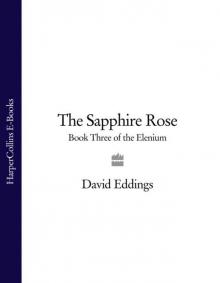 The Sapphire Rose
The Sapphire Rose King of the Murgos
King of the Murgos The Seeress of Kell
The Seeress of Kell Demon Lord of Karanda
Demon Lord of Karanda Pawn of Prophecy
Pawn of Prophecy Queen of Sorcery
Queen of Sorcery Castle of Wizardry
Castle of Wizardry Guardians of the West
Guardians of the West Sorceress of Darshiva
Sorceress of Darshiva The Shining Ones
The Shining Ones Enchanters' End Game
Enchanters' End Game Magician's Gambit
Magician's Gambit High Hunt
High Hunt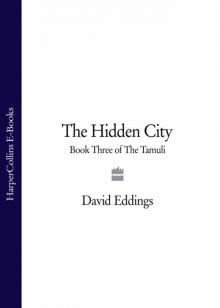 The Hidden City
The Hidden City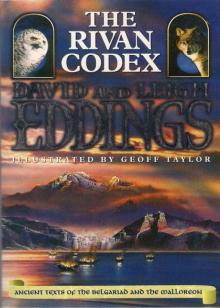 The Rivan Codex
The Rivan Codex Regina's Song
Regina's Song The Elder Gods
The Elder Gods The Malloreon: Book 02 - King of the Murgos
The Malloreon: Book 02 - King of the Murgos The Malloreon: Book 05 - Seeress of Kell
The Malloreon: Book 05 - Seeress of Kell Treasured One
Treasured One The Malloreon: Book 04 - Sorceress of Darshiva
The Malloreon: Book 04 - Sorceress of Darshiva The Malloreon: Book 03 - Demon Lord Of Karanda
The Malloreon: Book 03 - Demon Lord Of Karanda Belgarath the Sorcerer and Polgara the Sorceress
Belgarath the Sorcerer and Polgara the Sorceress The Malloreon: Book 01 - Guardians of the West
The Malloreon: Book 01 - Guardians of the West The Treasured One
The Treasured One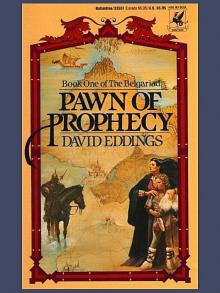 Pawn of Prophecy tb-1
Pawn of Prophecy tb-1 Polgara the Sorceress
Polgara the Sorceress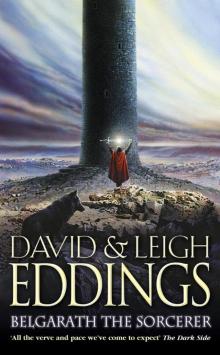 Belgarath the Sorcerer
Belgarath the Sorcerer The Younger Gods
The Younger Gods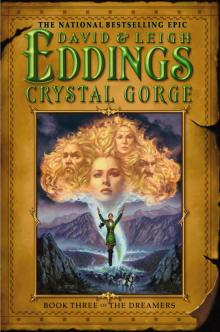 Crystal Gorge
Crystal Gorge